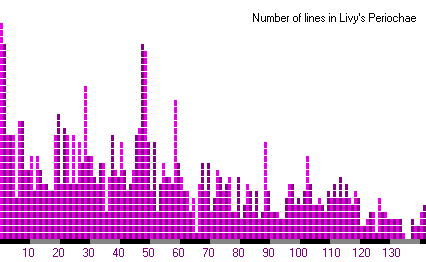Livy, The Periochae
Titus Livius or Livy (59 BCE - 17 CE): Roman historian, author of the authorized version of the history of the Roman republic.
The Periochae are not the only summary of Livy's History: in the Egyptian town Oxyrhynchus, a similar summary of books 37-40 and 48-55 was found on a scroll of papyrus that is now in Great Britain.note However the Oxyrhynchus Epitome is damaged and incomplete. This leaves us with the Periochae as our most important tool to reconstruct the general scope of Livy's monumental History of Rome from its beginning.
The books that were used by the maker of the Periochae appear to have been in bad condition. When we can control the text of the complete books with a summary (i.e., Books 1-10 and 21-45), sometimes the sequence of the events, as given in the Periochae, is not identical to that in the real books. At the very end, summaries of two books (136 and 137) are lacking, although it is possible that they have been integrated in the Periocha of book 141.
Another remarkable aspect of the Periochae is that they tend to become shorter, as is shown in the picture below. There is no explanation for this phenomenon. Probably the epitomator was simply tired, but it cannot be excluded that it partly reflects that Livy's books tend to become shorter, something is evident in books 30-45.

Overview
red-brown field: full text exists and a translation can be found here.
|
|
|
|
|
|
|
|
|
|
|
|
|
|
|
|
|
|
|
|
|
|
|
|
|
|
|
|
|
|
|
|
|
|
|
|
|
|
|
|
|
|
|
|
|
|
|
|
|
|
|
|
|
|
|
|
|
|
|
|
|
|
|
|
|
|
|
|
|
|
|
|
|
|
|
|
|
|
|
|
|
|
|
|
|
|
|
|
|
|
|
|
|
|
|
|
|
|
|
|
|
|
|
|
|
|
|
|
|
|
|
|
|
|
|
|
|
|
|
|
|
|
|
|
|
|
|
|
|
|
|
|
|
|
|
|
|
|
|
|
|
|
|
|
|
|
|
|
|
|
This rather free translation is by Jona Lendering. Thanks to Andrew Smith (www.attalus.org), who suggested many improvements for the translation.